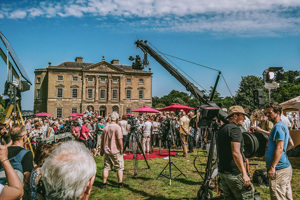Consecrated land and buildings
We are sometimes asked questions about the legal effect of the consecration of buildings or land and the circumstances in which these legal effects may be removed. This note will give a sketch of some of the issues but it must be emphasised that it cannot go far into the details of a complicated subject.
What is consecration of land or buildings?
The concept of the consecration of land or buildings is not confined to the Church of England. However this note will look at consecration in a limited and precise legal sense, that is consecration in accordance with ecclesiastical law, the law as it applies to the Church of England as the established church. Consecration in this sense is part of the law of the land and sometimes has consequences for persons who have otherwise no particular connection with the Church of England.
When property has been consecrated it is set apart solely for sacred purposes for all time (but see below). This is effected by the Bishop signing the sentence of consecration. In the case of ancient parish churches, consecration is presumed. It is only when consecrated that a building becomes in the eyes of the law a church.
Once land has been consecrated the land and everything on it comes within the jurisdiction of the ordinary who is normally, though not always, the diocesan bishop and thus within the faculty system (although a cathedral church is not within the faculty system, being governed instead by the Church of England Measures dealing specifically with cathedrals). If a church is within the faculty system then, subject to minor exceptions, no alterations, additions, removals or repairs to the fabric, ornaments or furniture of the church may be made without a faculty, which must be granted in most cases by the chancellor in the consistory court although the archdeacon also has power to grant faculties in some specific circumstances. Leases or licences over consecrated ground may only be granted under the authority of a faculty and only in limited circumstances. The effect of the faculty jurisdiction is thus to give legal protection to consecrated land against its use in an unfitting way. The jurisdiction also extends to the unconsecrated curtilage of a church.
The faculty jurisdiction is independent of the ownership of the consecrated land or buildings. Although consecrated ground will normally be owned by a body within the Church of England this is by no means always the case. The faculty jurisdiction extends to any consecrated portion of a cemetery, even if the cemetery is owned by a local authority or other secular body, and even in the case of a church monuments and occasionally parts of the fabric may be in private ownership. Some chapels in private premises, for example some school chapels, are consecrated. On the other hand, some Anglican places of worship have been dedicated but not consecrated, thus being set aside for sacred purposes without the legal protection of consecration.
Removal of the legal effects of consecration
Consecration is intended to be permanent. However, Parliament is sovereign and may remove the legal effects of consecration by legislation. This may also be done under the authority of a Measure of the Church of England, which has the full force and effect of an Act of Parliament.
One way in which Parliament may override the legal protection given by consecration is by authorising the taking of consecrated land for secular purposes inconsistent with its sacred character, for example for engineering works such as road or railway construction, something which became more common as the industrial revolution advanced. One classic example is the taking of much of the churchyard of Old St Pancras Church in London for railway construction associated with the construction of St Pancras Station in the 1860s (something which may quite fortuitously have benefited English literature by affecting the imagination of Thomas Hardy, who was at the time employed by an architectural practice and was given the job of supervising the exhumation of human remains made necessary by these works).
It is also possible, originally under primary legislation but nowadays under Church of England Measures, for parish churches to be closed to regular worship and disposed of for secular purposes. This was at one time done under the Union of Benefices Act 1860 but the relevant powers are now contained in the Mission and Pastoral Measure 2011. Section 74 provides that, where any consecrated building or part of a building or land is vested in the Church Commissioners under Section 71 of the Measure or is appropriated to a use or uses specified or described in a pastoral (church buildings disposal) scheme or a pastoral or church buildings scheme to which Section 58 or 59 applies or is vested in the diocesan board of finance in pursuance of a pastoral (church buildings disposal) scheme (none of which could happen unless the building was closed for regular public worship), then, unless the scheme otherwise provides:
(a) the building or part of a building or land shall not be subject to the legal effects of consecration, and
(b) in particular, the jurisdiction of any court or person with respect to the granting of faculties shall cease to extend to the building or part of the building or land.
The section goes on, interestingly, to provide that if any building or part of a building or land to which the section applies is subsequently restored to its former use or is appropriated to another use for which consecration would be required the section shall cease to apply. Thus the removal of the legal effects of consecration may only be of a temporary nature.
There is a quite separate provision, contained in Section 22 of the Care of Churches and Ecclesiastical Jurisdiction Measure 1991, under which the bishop of a diocese on the application of the archdeacon in respect of any building or land in the archdeaconry which is subject to the legal effects of consecration, is satisfied that (i) the building or land is not held or controlled by any ecclesiastical corporation or by any Diocesan Board of Finance; and (ii) no purpose will be served by its remaining subject to the legal effects of consecration, he may by order direct that the building or land or part of the building or land shall not be subject to the legal effects of consecration. Such an order may impose conditions and requirements, which take effect as local land charges.
However, the fact that consecrated land has ceased in practice to be used for sacred purposes does not in itself end the legal effects of consecration. In the reported case of Re St John’s Chelsea [1962] 2 All ER 850 a parish church had been entirely demolished by enemy action in 1940. The ruins were subsequently cleared away. The consistory court refused a petition for the use of the consecrated church site, which was derelict at the time, for a car park. Although there was no current intention of rebuilding the church on the old site, no definite decision had been taken and there was no evidence that the purpose for which the ground had been consecrated could no longer lawfully be carried out. The court considered that it had no jurisdiction to grant the petition, although the position might have been different had it not been legally possible to rebuild the church on the original site.
The case Parker v Leach (1866-67) LR1PC312
Some of the legal issues raised by the concept of consecration were considered in this rather bizarre case. Though it is an old case it is still of interest, partly because it is rare for this sort of issue to reach this level in the judicial system – this was a case heard by the Judicial Committee of the Privy Council on appeal from the Chancery Court of York.
The case concerned the parish church of Waddington, in Yorkshire. In the year 1825 this church had been, under the authority of a faculty, almost entirely demolished and rebuilt, although the tower, the east wall of the nave and, apparently, part of the chancel walls had been retained. Mr Leach had occupied a pew in the chancel, which was the property of the owner of the local manor house (these were the days in which pews were often in private ownership) continuously from the rebuilding in 1825 until December 1863 when the incumbent, without the authority of the churchwardens, brought a carpenter into the chancel and had him pull down and entirely destroy the pew which Mr Leach had been in the habit of enjoying.
There is no explanation in the report of the reasons for this bizarre action, which was presumably part of a wider dispute.
Mr Leach brought proceedings in the York consistory court. One of the arguments raised by the Reverend Parker was the rather bizarre one that the court had no jurisdiction because the church was not a church. Since it had been largely demolished in 1825 it had ceased to be a church at that time and since it had not been reconsecrated it had never again become a church.
The court dismissed this argument. It was careful to confine its decision to the particular facts. One of the grounds for the decision was the fact that the partial demolition and reconstruction had been undertaken under the authority of a faculty: the privy council considered that something done under the authority of a faculty could not have had the effect of removing the church from the faculty jurisdiction. Another ground for the decision was the fact that the building had remained continuously in use as a parish church while the demolition and rebuilding were going on, marriages being celebrated in the tower whilst the church was in the act of being rebuilt and also being celebrated within its incipient walls. Baptisms had also been performed. It was impossible to suppose that under such circumstances the building could have become desecrated and so stripped of its original sacred character as to require that it should be again consecrated. However, the privy council clearly considered that if a church was rebuilt upon the old lines of foundation, including within it the same originally consecrated ground, and no more, such a church did not need reconsecration. This was despite some very old ecclesiastical authority suggesting that if a church was entirely destroyed and rebuilt that new building was not a church until it had been reconsecrated.
Consecrated burial grounds
The custom of burial in churchyards is an ancient one and at common law parishioners and others dying within the parish have a right of burial in the parish churchyard. However the great expansion of the population of cities as a result of the industrial revolution led to the overcrowding of churchyards in urban areas, especially in central London. The problem was addressed by the establishment, under Parliamentary authority, of cemetery companies and burial boards which provided new cemeteries outside built up areas. The Burial Act 1853 provided for the closure of urban burial grounds to future burials by order in council.
Although these new cemeteries were provided by secular bodies, it was thought appropriate to accommodate the wishes of those who still wished to be buried in consecrated ground and, accordingly, Parliament empowered these secular organisations to approach the diocesan bishop to consecrate a portion of the new cemeteries. It is thus usual for a part, though not the whole of a municipal cemetery (local authorities have now taken over the functions of the old burial boards) to be consecrated. This brings that part of the cemetery within the faculty jurisdiction but it has been said judicially that this jurisdiction is to be sparingly exercised and the power to make a restoration order following an unlawful act does not extend to the consecrated parts of local authority cemeteries. However, certain acts affecting the consecrated part of a municipal ceremony, including exhumation, remain unlawful if carried out without the authority of a faculty.
This article was written by George Duncan. For more information please get in touch with George on +44 (0)20 7203 5054 or via George.Duncan@crsblaw.com.








































